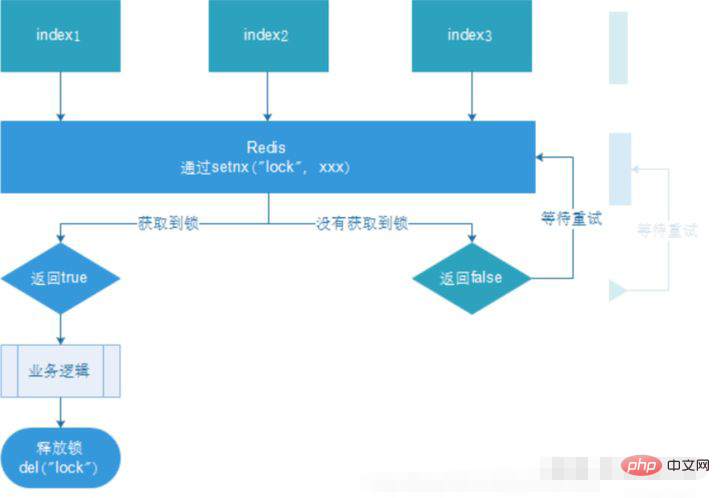What is the implementation principle of redis distributed lock
With the help of the command setnx(key, value) in redis, if the key does not exist, it will be added, and if it exists, nothing will be done. If multiple clients send the setnx command at the same time, only one client can succeed and return 1 (true); other clients return 0 (false).

The operating environment of this tutorial: Windows 7 system, Redis version 5.0.10, DELL G3 computer.
Implementation of distributed locks
With the needs of business development, the original single-machine deployed system has evolved into a distributed cluster system. Since the distributed system is multi-threaded, multi-process and distributed, On different machines, this will invalidate the concurrency control lock strategy in the original single-machine deployment. The simple Java API cannot provide distributed lock capabilities. In order to solve this problem, a cross-JVM mutual exclusion mechanism is needed to control access to shared resources. This is the problem that distributed locks need to solve!
Mainstream implementation of distributed locks:
Implementing distributed locks based on database
Based on cache (Redis, etc.)
Based on Zookeeper
Here, we implement distributed locks based on redis.
Basic implementation
With the help of the command setnx(key, value) in redis, if the key does not exist, it will be added, and if it exists, nothing will be done. If multiple clients send the setnx command at the same time, only one client can succeed and return 1 (true); other clients return 0 (false).

Mainly use the Redis Setnx command
When the specified key does not exist, set the specified value for the key
Set successfully and return 1 . The setting fails and returns 0
redis> EXISTS job # job 不存在 (integer) 0 redis> SETNX job "programmer" # job 设置成功 (integer) 1 redis> SETNX job "code-farmer" # 尝试覆盖 job ,失败 (integer) 0 redis> GET job # 没有被覆盖 "programmer"
java code
public void testLock() {
// 执行redis的setnx命令
String uuid = UUID.randomUUID().toString();
Boolean lock = redisTemplate.opsForValue().setIfAbsent("lock", uuid, 5, TimeUnit.SECONDS);
// 判断是否拿到锁
if (lock) {
// 执行业务逻辑代码
// ...
// 释放锁资源 (保证获取值和删除操作的原子性) LUA脚本保证删除的原子性
String script = "if redis.call('get', KEYS[1]) == ARGV[1] then
return redis.call('del', KEYS[1]) else return 0 end";
this.redisTemplate.execute(new DefaultRedisScript<>(script),
Arrays.asList("lock"), Arrays.asList(uuid));
// if (StrUtil.equals(uuid,redisTemplate.opsForValue().get("lock"))){
// redisTemplate.delete("lock");
// }
} else {
// 其他请求尝试获取锁
testLock();
}
}In order to ensure that the distributed lock is available, we must at least ensure that the lock implementation meets the following four conditions at the same time:
Mutual exclusion sex. At any time, only one client can hold the lock.
No deadlock will occur. Even if a client crashes while holding the lock without actively unlocking it, it is guaranteed that other clients can subsequently lock it.
The trouble should end it. The locking and unlocking must be done by the same client. The client itself cannot unlock the lock added by others.
Recommended related tutorials: Redis Tutorial
The above is the detailed content of What is the implementation principle of redis distributed lock. For more information, please follow other related articles on the PHP Chinese website!

Hot AI Tools

Undresser.AI Undress
AI-powered app for creating realistic nude photos

AI Clothes Remover
Online AI tool for removing clothes from photos.

Undress AI Tool
Undress images for free

Clothoff.io
AI clothes remover

Video Face Swap
Swap faces in any video effortlessly with our completely free AI face swap tool!

Hot Article

Hot Tools

Notepad++7.3.1
Easy-to-use and free code editor

SublimeText3 Chinese version
Chinese version, very easy to use

Zend Studio 13.0.1
Powerful PHP integrated development environment

Dreamweaver CS6
Visual web development tools

SublimeText3 Mac version
God-level code editing software (SublimeText3)

Hot Topics
 1665
1665
 14
14
 1424
1424
 52
52
 1322
1322
 25
25
 1269
1269
 29
29
 1249
1249
 24
24
 How to build the redis cluster mode
Apr 10, 2025 pm 10:15 PM
How to build the redis cluster mode
Apr 10, 2025 pm 10:15 PM
Redis cluster mode deploys Redis instances to multiple servers through sharding, improving scalability and availability. The construction steps are as follows: Create odd Redis instances with different ports; Create 3 sentinel instances, monitor Redis instances and failover; configure sentinel configuration files, add monitoring Redis instance information and failover settings; configure Redis instance configuration files, enable cluster mode and specify the cluster information file path; create nodes.conf file, containing information of each Redis instance; start the cluster, execute the create command to create a cluster and specify the number of replicas; log in to the cluster to execute the CLUSTER INFO command to verify the cluster status; make
 How to clear redis data
Apr 10, 2025 pm 10:06 PM
How to clear redis data
Apr 10, 2025 pm 10:06 PM
How to clear Redis data: Use the FLUSHALL command to clear all key values. Use the FLUSHDB command to clear the key value of the currently selected database. Use SELECT to switch databases, and then use FLUSHDB to clear multiple databases. Use the DEL command to delete a specific key. Use the redis-cli tool to clear the data.
 How to read redis queue
Apr 10, 2025 pm 10:12 PM
How to read redis queue
Apr 10, 2025 pm 10:12 PM
To read a queue from Redis, you need to get the queue name, read the elements using the LPOP command, and process the empty queue. The specific steps are as follows: Get the queue name: name it with the prefix of "queue:" such as "queue:my-queue". Use the LPOP command: Eject the element from the head of the queue and return its value, such as LPOP queue:my-queue. Processing empty queues: If the queue is empty, LPOP returns nil, and you can check whether the queue exists before reading the element.
 How to configure Lua script execution time in centos redis
Apr 14, 2025 pm 02:12 PM
How to configure Lua script execution time in centos redis
Apr 14, 2025 pm 02:12 PM
On CentOS systems, you can limit the execution time of Lua scripts by modifying Redis configuration files or using Redis commands to prevent malicious scripts from consuming too much resources. Method 1: Modify the Redis configuration file and locate the Redis configuration file: The Redis configuration file is usually located in /etc/redis/redis.conf. Edit configuration file: Open the configuration file using a text editor (such as vi or nano): sudovi/etc/redis/redis.conf Set the Lua script execution time limit: Add or modify the following lines in the configuration file to set the maximum execution time of the Lua script (unit: milliseconds)
 How to use the redis command line
Apr 10, 2025 pm 10:18 PM
How to use the redis command line
Apr 10, 2025 pm 10:18 PM
Use the Redis command line tool (redis-cli) to manage and operate Redis through the following steps: Connect to the server, specify the address and port. Send commands to the server using the command name and parameters. Use the HELP command to view help information for a specific command. Use the QUIT command to exit the command line tool.
 How to implement redis counter
Apr 10, 2025 pm 10:21 PM
How to implement redis counter
Apr 10, 2025 pm 10:21 PM
Redis counter is a mechanism that uses Redis key-value pair storage to implement counting operations, including the following steps: creating counter keys, increasing counts, decreasing counts, resetting counts, and obtaining counts. The advantages of Redis counters include fast speed, high concurrency, durability and simplicity and ease of use. It can be used in scenarios such as user access counting, real-time metric tracking, game scores and rankings, and order processing counting.
 How to set the redis expiration policy
Apr 10, 2025 pm 10:03 PM
How to set the redis expiration policy
Apr 10, 2025 pm 10:03 PM
There are two types of Redis data expiration strategies: periodic deletion: periodic scan to delete the expired key, which can be set through expired-time-cap-remove-count and expired-time-cap-remove-delay parameters. Lazy Deletion: Check for deletion expired keys only when keys are read or written. They can be set through lazyfree-lazy-eviction, lazyfree-lazy-expire, lazyfree-lazy-user-del parameters.
 How to optimize the performance of debian readdir
Apr 13, 2025 am 08:48 AM
How to optimize the performance of debian readdir
Apr 13, 2025 am 08:48 AM
In Debian systems, readdir system calls are used to read directory contents. If its performance is not good, try the following optimization strategy: Simplify the number of directory files: Split large directories into multiple small directories as much as possible, reducing the number of items processed per readdir call. Enable directory content caching: build a cache mechanism, update the cache regularly or when directory content changes, and reduce frequent calls to readdir. Memory caches (such as Memcached or Redis) or local caches (such as files or databases) can be considered. Adopt efficient data structure: If you implement directory traversal by yourself, select more efficient data structures (such as hash tables instead of linear search) to store and access directory information




